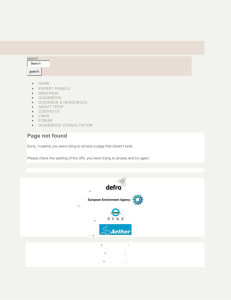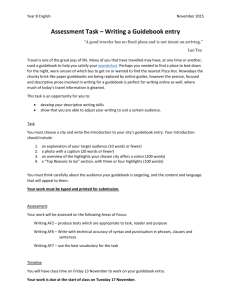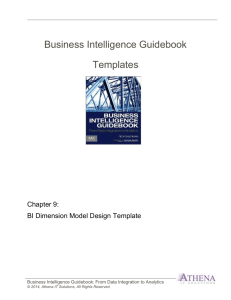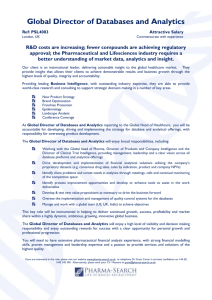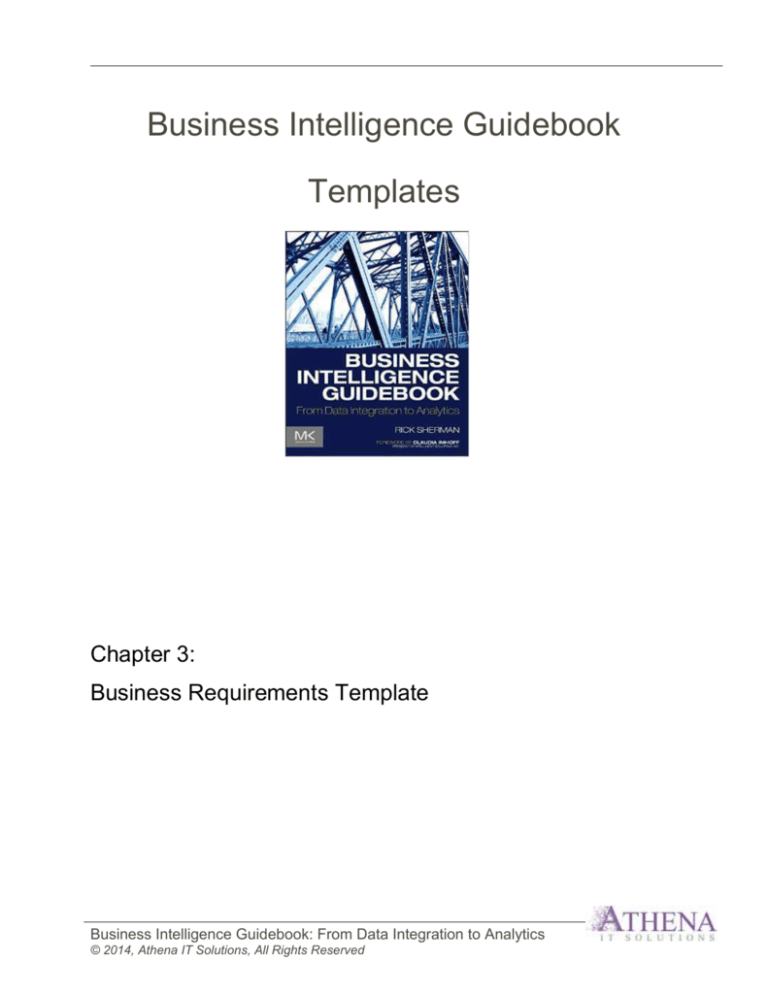
Business Intelligence Guidebook
Templates
Chapter 3:
Business Requirements Template
Business Intelligence Guidebook: From Data Integration to Analytics
© 2014, Athena IT Solutions, All Rights Reserved
BI Roadmap, [Project Name]
[Select Date]
[Company Name]
BI Requirements
[Project Name]
Date: [Select Date]
Author(s):
Sponsor(s):
Business Intelligence Guidebook: From Data Integration to Analytics
© Athena IT Solutions, All Rights Reserved
Page 1 of 16
BI Roadmap, [Project Name]
[Select Date]
TABLE OF CONTENTS
EXECUTIVE SUMMARY .......................................................................................................... 5
PROJECT DESCRIPTION ................................................................................................................. 5
KEY DELIVERABLES .................................................................................................................... 5
CRITICAL SUCCESS FACTORS ....................................................................................................... 5
RISKS AND CONCERNS ................................................................................................................. 5
BUSINESS REQUIREMENTS ................................................................................................... 6
[REQUIREMENT NAME] ................................................................................................................ 6
Requirement description .............................................................................................................................6
Data sources ...............................................................................................................................................6
Business and data transformations .............................................................................................................7
Business metrics or Key Performance Indicators (KPIs) ...........................................................................7
Business processes......................................................................................................................................7
List business groups involved and describe type of involvement ................................................................7
List business owner(s) ................................................................................................................................7
List subject matter expert(s) .......................................................................................................................7
DATA AND DATA QUALITY REQUIREMENTS.................................................................. 8
DATA SOURCES ............................................................................................................................ 8
DATA CLEANSING ........................................................................................................................ 8
MASTER DATA MANAGEMENT (MDM) ....................................................................................... 8
DATA ACQUISITION ...................................................................................................................... 8
FUNCTIONAL REQUIREMENTS .......................................................................................... 10
BI USE CASES ............................................................................................................................. 10
ANALYTICAL PROCESS WORKFLOW AND USER INTERACTION ..................................................... 10
ANALYTICAL STYLES NEEDED .................................................................................................... 10
REGULATORY/COMPLIANCE REQUIREMENTS ........................................................... 11
TECHNICAL REQUIREMENTS ............................................................................................ 12
REQUIREMENTS CROSS-MATRIX ..................................................................................... 13
PRIORITIZING REQUIREMENTS ........................................................................................ 14
APPROVALS .............................................................................................................................. 15
APPENDIX: INPUTS FOR REQUIREMENTS ..................................................................... 16
Business Intelligence Guidebook: From Data Integration to Analytics
© Athena IT Solutions, All Rights Reserved
Page 2 of 16
BI Roadmap, [Project Name]
[Select Date]
INTERVIEWEES ........................................................................................................................... 16
DATA SOURCES EXAMINED ........................................................................................................ 16
DATA SOURCE SYSTEMS DOCUMENTATION ................................................................................ 16
REPORTING SYSTEMS, REPORTS AND DATA SHADOW SYSTEMS EXAMINED ................................. 16
AUTHORS AND CONTRIBUTORS .................................................................................................. 16
Business Intelligence Guidebook: From Data Integration to Analytics
© Athena IT Solutions, All Rights Reserved
Page 3 of 16
BI Roadmap, [Project Name]
[Select Date]
Remember that the content of the template is more important than how is presented or
formatted.
Note: to delete any tip, such as this one, just click the tip text and then press the
spacebar.
This template presents a deliverable that contains the complete set of requirements for a
DW or BI project. Some enterprises may split this requirements document into two. The
first part would have a high-level list of business requirements with priorities; the second
would document more detailed requirements.
The key topics in the requirements documentation include:
Business requirements
Data requirements
Current state reporting assessment
Feasibility analysis
Critical success criteria
There are specific techniques or tools that you can use when gathering various
requirements:
Business requirements
o Interviews
o Review documents and presentations on business initiatives and supporting
data needs
o Examine existing reports if plan is to replace
Data requirements
o Data profiling
o Output from data modeling, ETL and BI tools
Functional requirements
o Storyboards
o BI mock-ups
o Prototyping
Current state of reporting
o Sample reports or spreadsheets
o Sample data
Business Intelligence Guidebook: From Data Integration to Analytics
© Athena IT Solutions, All Rights Reserved
Page 4 of 16
BI Roadmap, [Project Name]
[Select Date]
EXECUTIVE SUMMARY
Write this last so that you can summarize the most important points from your business
justification.
Project description
Provide a brief explanation of the project’s goals and objectives.
Key Deliverables
Provide a brief explanation of the project’s deliverables and resulting capabilities.
Critical Success Factors
Provide a brief explanation of the project’s dependencies or prerequisites.
Risks and Concerns
Provide a brief explanation of the project’s risks and outstanding concerns.
Business Intelligence Guidebook: From Data Integration to Analytics
© Athena IT Solutions, All Rights Reserved
Page 5 of 16
BI Roadmap, [Project Name]
[Select Date]
BUSINESS REQUIREMENTS
A reminder: these are preliminary requirements and not intended to be
specifications. Fill in the details when creating data integration and BI application
requirements and specifications. Avoid the common mistake of treating
requirements at this stage at a too-high level and providing incomplete and
ambiguous descriptions. Ambiguous requirements create a wide gap between what
business people expect and what IT thinks it’s creating, leading to project failure.
Table 1: List of Business Requirements
Identifier
Name
Description
Priority
[Requirement Name]
Repeat this section for each business requirement.
Requirement description
Provide a brief description of the requirement in a business context. This is best
supplied by this requirement’s business owner.
Data sources
List the data sources as the business owner would describe them. More details will
be provided in the data and data quality requirements section.
Business Intelligence Guidebook: From Data Integration to Analytics
© Athena IT Solutions, All Rights Reserved
Page 6 of 16
BI Roadmap, [Project Name]
[Select Date]
Business and data transformations
Identify and briefly describe in business terminology the key business and data
transformations required. Data integration and BI application specifications will
provide details.
Business metrics or Key Performance Indicators (KPIs)
Identify and briefly describe in business terminology the key business metrics and
KPIs that will need to be calculated for this requirement. Data integration and BI
application specifications will provide details.
Business processes
Identify and briefly describe in business terminology the key business processes that
will be involved in or impacted by this requirement. Data integration and BI
application specifications will provide details.
List business groups involved and describe type of involvement
List the business groups involved with this requirement and their role in relation to
this requirement. One of the key project role attributes will be whether they are data
creators, information consumers or both.
List business owner(s)
List business owners of this requirement. Include their names, titles, organizational
groups and project roles.
List subject matter expert(s)
List SMEs of this requirement including their names, titles, organizational groups
and project roles.
Business Intelligence Guidebook: From Data Integration to Analytics
© Athena IT Solutions, All Rights Reserved
Page 7 of 16
BI Roadmap, [Project Name]
[Select Date]
DATA AND DATA QUALITY REQUIREMENTS
Business requirements need to be detailed enough to identify the data sources or
Systems of Record (SOR), such as applications, databases or files needed to build
the BI deliverables. In addition to identifying the data sources, identify the data
integration and data quality requirements. Although data integration and BI
application specifications will get into the details, this document needs to identify
these requirements and briefly describe them. See pages 50-52 of the BI Guidebook
for details and a data requirements workflow.
Data sources
List the data sources required. For each, include its current status in relation to BI
(whether it’s a new or existing source, or an existing source that needs more data
extracted than currently obtained), state of its data quality, business/technology
owners and subject matter experts (SMEs).
Data cleansing
Describe the data integration and cleansing requirements that have been identified
to use the data sources for BI and analytics. Often, these requirements are created
because of inconsistencies between data sources rather than data issues
encountered when using the data source application by itself.
Master Data Management (MDM)
Describe the MDM requirements that have been identified to use the data sources
for BI and analytics. The most common MDM needs involve customer data, often
referred to as Customer Data Integration (CDI), or product data, often referred to
as Product Information Management (PIM). Sometimes the scope of these
requirements is sufficient to justify a standalone MDM project that may be a
prerequisite to fulfilling specific business requirements.
Data acquisition
Occasionally, analytical processes require data that the organization does not have
either because it has not ever been captured or has not been obtained from an
external source.
Business Intelligence Guidebook: From Data Integration to Analytics
© Athena IT Solutions, All Rights Reserved
Page 8 of 16
BI Roadmap, [Project Name]
[Select Date]
Describe the data acquisition requirements and list the business decision regarding
its fulfillment. If the data needs to be acquired then it is a project dependency, and
you need to list the specific business requirements impacted.
Business Intelligence Guidebook: From Data Integration to Analytics
© Athena IT Solutions, All Rights Reserved
Page 9 of 16
BI Roadmap, [Project Name]
[Select Date]
FUNCTIONAL REQUIREMENTS
See page 52 of the BI Guidebook for important instructions on creating functional
requirements. Briefly, BI functional requirements need to include the following:
BI use cases
Analytical process workflow and user interaction
Analytical or BI styles needed
BI use cases
BI use cases are explained on page 53 of the BI Guidebook. See
www.BIguidebook.com for links to examples on vendor websites.
Briefly describe the BI use cases. More details will be provided in BI specifications.
Analytical process workflow and user interaction
Briefly describe the analytical workflow and business user interaction involved by
listing the business and analysis processes for each BI use case. More details will be
provided in BI specifications.
Analytical styles needed
Describe the analytical or BI styles needed. (See page 386 of the BI Guidebook for
information on styles.) Indicate if the styles apply to specific BI use cases or to all. It
is also useful to identify the styles according to the BI role that a business person
may fulfill (e.g., “power user” who would create reports/dashboards, report readers
who merely examine the data presented to them or analysts who need to perform
what-ifs and drill into more details).
Business Intelligence Guidebook: From Data Integration to Analytics
© Athena IT Solutions, All Rights Reserved
Page 10 of 16
BI Roadmap, [Project Name]
[Select Date]
REGULATORY/COMPLIANCE REQUIREMENTS
When you’re gathering requirements, be aware that people you’re working with
either may not know all the relevant and required compliance and regulatory rules,
or may assume that you already know them. See page 53 of the BI Guidebook for
examples of regulatory requirements.
List and briefly describe the regulatory and compliance requirements
Business Intelligence Guidebook: From Data Integration to Analytics
© Athena IT Solutions, All Rights Reserved
Page 11 of 16
BI Roadmap, [Project Name]
[Select Date]
TECHNICAL REQUIREMENTS
The project may need to comply with technical requirements issued by the CIO, IT
or business group. There may be no discretionary leeway for these, so be sure to ask
about them up front. Check page 54 of the BI Guidebook for a reminder on these.
List and describe the technology requirements, what business requirements are
impacted and, if applicable, the range of options to comply with requirements.
Business Intelligence Guidebook: From Data Integration to Analytics
© Athena IT Solutions, All Rights Reserved
Page 12 of 16
BI Roadmap, [Project Name]
[Select Date]
REQUIREMENTS CROSS-MATRIX
Consolidate and coordinate the varied requirements into a cohesive set of BI project
requirements to determine which ones truly drive value. See page 55 of the BI
Guidebook for the dimensions by which you should categorize the requirements.
Chapter 18 provides further discussion.
Classify and list the requirements according to agreed-upon categories.
Business Intelligence Guidebook: From Data Integration to Analytics
© Athena IT Solutions, All Rights Reserved
Page 13 of 16
BI Roadmap, [Project Name]
[Select Date]
PRIORITIZING REQUIREMENTS
Never accept that every requirement is a top priority. The business needs to classify
the requirements into categories such as:
Must-have
Should-have
Nice-to-have
Forget about it
See page 56 of the BI Guidebook for more on this.
List each requirement, its priority and business owner.
Business Intelligence Guidebook: From Data Integration to Analytics
© Athena IT Solutions, All Rights Reserved
Page 14 of 16
BI Roadmap, [Project Name]
[Select Date]
APPROVALS
It is a best practice to obtain sign-off approval of each project milestone. An
organization’s policies and culture will dictate who the approvers are, but typically
the sponsors and key stakeholders are included.
Title
Name
Business Intelligence Guidebook: From Data Integration to Analytics
© Athena IT Solutions, All Rights Reserved
Approval
Date
Page 15 of 16
BI Roadmap, [Project Name]
[Select Date]
APPENDIX: INPUTS FOR REQUIREMENTS
Interviewees
List all people interviewed with their name, title, organizational group and project
role if applicable. List all dates when that person participated in interviews,
meetings or discussions. If the person’s involvement was extensive then skip listing
the dates and describe their involvement.
Data sources examined
List all the data sources – databases, applications, files and external systems –
examined to create this deliverable. List all sources examined regardless of whether
they will become required data sources for this project.
Data source systems documentation
List and briefly describe the regulatory and compliance requirements
Reporting systems, reports and data shadow systems examined
List and briefly describe the regulatory and compliance requirements
Authors and contributors
List all the people involved in obtaining and analyzing the requirements along with
the authors of this deliverable.
Business Intelligence Guidebook: From Data Integration to Analytics
© Athena IT Solutions, All Rights Reserved
Page 16 of 16

